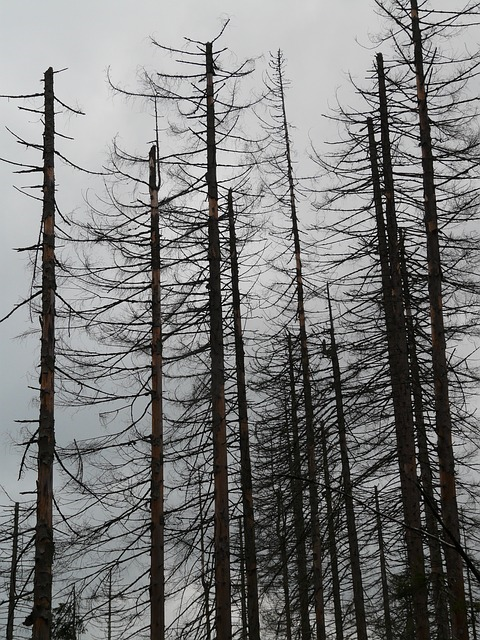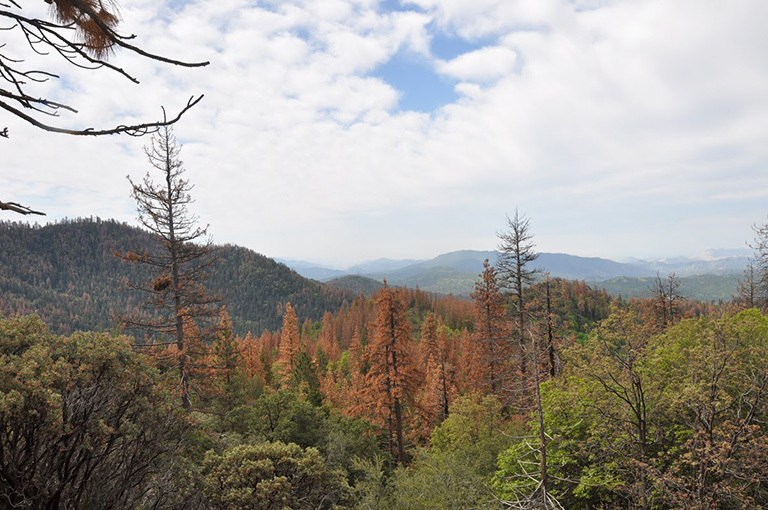
Dead and dying ponderosa (Pinus ponderosa) and sugar pine (P. lambertiana) in the Hume Lake
Ranger District, Sequoia National Forest, California. Credit: USDA Forest Service
August 21, 2016
If you’ve been keeping up on forest news, you know that the latest estimate is that 66 million trees in the Sierra Nevada are dead—victims of drought-induced susceptibility to a bark beetle infestation.
There are still places where you can drive or hike in the Sierra and see no sign of the dead trees. But that is probably temporary. As the tree death numbers mount, and as the scourge moves from the Southern Sierra to parts north, some are predicting that the dead trees will be visible to everyone living or traveling in California’s forested areas.
A Sierra Club member living in the Sierra called me last week to give me an update on what she sees in her neighborhood. More than 200 trees have died around her, including three 300-year-old ponderosa pines in her yard.
These are pines that have been hit by beetles at various times in their long lives. But this time, the beetles came with the worst drought since weather monitors started keeping records in California.
She tried to rescue the trees by watering, and spent hundreds of dollars on pesticides—something she never would have predicted she’d ever spend money on. But the trees still died. Where she once looked out her windows and saw limbs and endless pine needles, she now sees open sky.
At times, the insects will swarm, a black cloud speeding through the sky in search of another grove of trees to infest.
“It’s like a sci-fi movie,” she said. “It feels pretty hopeless. I think the Sierra won’t be defined by green trees and I don’t think people get it. I don’t think we get it.”
This isn’t a temporary problem. Our forests throughout the west, and particularly in California, are the most obvious early victims of climate change.
 Yet, even though scientists have warned since at least 1999 that infestation and forest death could be among the effects of climate change, policymakers have been caught off guard.
Yet, even though scientists have warned since at least 1999 that infestation and forest death could be among the effects of climate change, policymakers have been caught off guard.
There has always been a strange disconnect between what’s actually happening in the forest and how forest policy is being crafted and carried out. The tree die-off illuminates this disconnect.
For instance, on the one hand, in October, the governor proclaimed a state of emergency and established a task force composed of some agencies and stakeholders representing various interests, to figure out how to staunch the bleeding.
On the other, the largest clear cutter in the state, Sierra Pacific Industries, is continuing to operate on project permits that assume that the forest is as healthy as it was more than 15 years ago. The company is cutting trees—healthy, green trees—as fast as ever. There’s no apparent effort to revoke the permits to halt the cutting while the broader forest damage, and the future of forests, are assessed.
Meanwhile, at the legislature, the main action on forests seems to be geared toward easing requirements for harvesting healthy big trees on private land to help feed some biomass incinerators serving one legislator’s district.
As I write this, some Assembly Democrats are hemming and hawing about whether to support bills by Senate Democrats that will solidify and extend California’s efforts to cut the pollution that creates climate change.
Really.
Even in California, even as climate change’s early effects are right here, in our backyard: Drought. Hotter summers. Infestation. Dead forests.
Those legislators don’t want to buck the wishes of the polluting industries that oppose climate legislation.
That Sierra Club member in the Sierra, a witness to the forests’ death, could have been talking about those legislators: They still don’t get it.
Sincerely,

Kathryn Phillips
Director
Sierra Club California is the Sacramento-based legislative and regulatory advocacy arm of the 13 California chapters of the Sierra Club.
Please consider becoming a sustaining donor.
